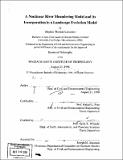A nonlinear river meandering model and its incorporation in a landscape evolution model
Author(s)
Lancaster, Stephen Thomas, 1967-
DownloadFull printable version (45.06Mb)
Advisor
Rafael L. Bras and Kelin X. Whipple.
Terms of use
Metadata
Show full item recordAbstract
A topographic steering river meandering (TSRM) model based on continuity of a simplified flow field through bends is developed. The equilibrium coupling between helical flow and sediment transport, as in Ikeda [1989] determines downstream variation of transverse bed slope. The model tests the hypothesis that meander development patterns can be captured under the assumptions: (a) bank shear stress arises from forces associated with topographically induced convective accelerations; (b) turbulent boundary layer dissipation of these forces at the banks is sufficiently represented by gaussian smoothing at a parameterized scale; and (c) lateral migration of the channel is proportional to bank shear stress. The resulting TSRM model produces realistic complex meander patterns and scroll bar-like topography. Model compound bend formation is compared to a field case and found to arise from the nonlinear interaction of bank roughness and channel hydraulics scales. When the latter is short relative to the former, maximum bank shear stress occurs early in the bend and leads to compound bend formation. New statistical stream sinuosity and spatial coordinate variation measures are applied to both natural and model streams and reveal secondary sinuosities arising from compound bend formation in both cases. Scroll bar topography and channel bank roughness are studied in the field to compare natural and model mechanisms. A channel-hillslope integrated landscape development (CHILD) model incorporates the TSRM model. The CHILD model represents the landscape as an irregular, Delaunay triangulated mesh of landscape nodes that may be moved, deleted, or added to accommodate meandering channels that are in general discretized at different spatial resolution than the surrounding landscape. The interactions among meandering, bank erodibility's bank height dependence, and uplift rate in a detachment-limited river valley are examined. An equilibrium landscape adjusts to the onset of meandering and approaches a new dynamic equilibrium. For the detachment-limited case, the hypothesis that meandering is more active when uplift is quiescent is rejected. When bank erodibility's bank height dependence is greater, bend scale sinuosity is smaller, but the tendency toward multi-bend loop formation is reinforced.
Description
Thesis (Ph.D.)--Massachusetts Institute of Technology, Dept. of Civil and Environmental Engineering, 1998. Includes bibliographical references (p. 267-277).
Date issued
1998Department
Massachusetts Institute of Technology. Department of Civil and Environmental EngineeringPublisher
Massachusetts Institute of Technology
Keywords
Civil and Environmental Engineering